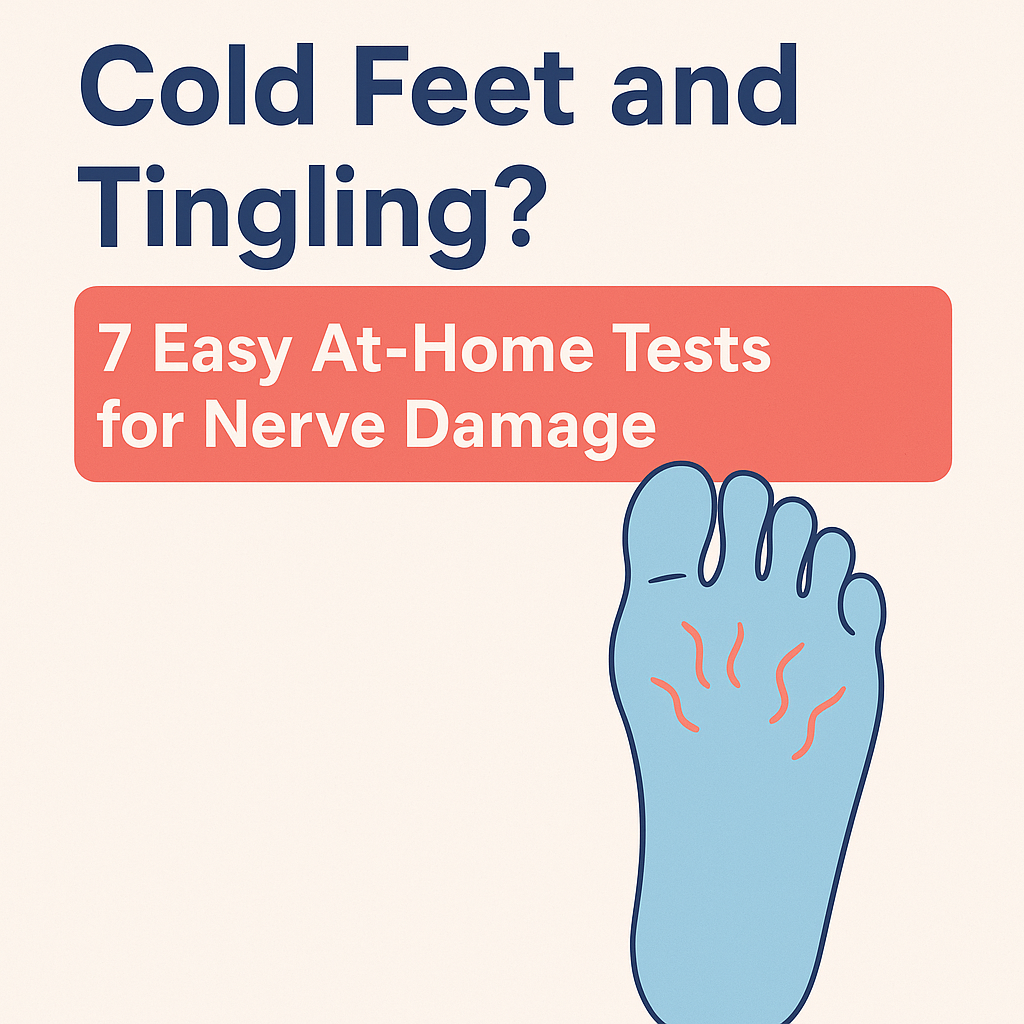
⚠️ Affiliate Disclaimer: This post may contain affiliate links, which means I may earn a small commission — at no extra cost to you — if you make a purchase through one of these links. I only recommend products or services I genuinely trust and believe can provide value. Thank you for supporting My Medical Muse!
Cold Feet and Tingling? 7 Easy At-Home Tests for Nerve Damage
Have you ever wondered why one or both of your feet feel icy cold even when it’s warm? Or why you sometimes feel a strange tingling, crawling, or buzzing in your toes that just won’t go away?
While these symptoms might seem harmless, they could be warning signs of something more serious.
The good news? You don’t have to wait for a doctor’s appointment to take action. In this post, you’ll learn how to screen yourself using simple, science-backed home tests for nerve damage plus what those cold, tingling feet might really be telling you.
What Is Peripheral Neuropathy?
Peripheral neuropathy happens when the nerves outside your brain and spinal cord (the “peripheral nerves”) are damaged. These nerves help control everything from sensation in your toes to your ability to walk, feel pain, or regulate temperature.When these nerves are irritated or injured, you might feel:
- Tingling or pins and needles
- Burning or stabbing sensations
- Numbness or reduced sensation
- Muscle weakness
- Feet that feel cold or are cold to the touch.
Neuropathy can be caused by a variety of conditions, including:
- Diabetes or prediabetes
- Vitamin deficiencies (especially B12)
- Autoimmune diseases
- Chronic alcohol use
- Chemotherapy
- Spinal problems or pinched nerves.
Read More: About Peripheral Neuropathy
Why Are My Feet Cold and Tingling?
Cold feet are often blamed on poor circulation, but that’s not the full story. Sometimes, cold sensations are actually due to nerve dysfunction, not just blood flow issues, that means your brain thinks your foot is cold even if it’s not physically cold to the touch.
When tingling or numbness joins the party, that’s an even stronger clue that your nerves are involved. In other words, Cold and tingling is a red flag for early neuropathy.
7 At-Home Tests to Check for Nerve Problems in Your Feet
These simple DIY tests can’t replace a doctor’s diagnosis, but they can give you a pretty good idea if something’s off.
The Vibration Test (Tuning Fork Substitute):
it checks the sensory nerve function, especially large fiber nerves.
What you’ll need: Electric toothbrush or vibrating phone
How to do it:
- Turn on the toothbrush or vibration mode on your phone.
- Place the vibrating surface against the top of your big toe.
- Can you feel the vibration clearly?
- Now, repeat on the other foot.
What it means: If vibration feels dull, weak, or absent on one or both sides, it could be an early sign of sensory nerve damage.
The Temperature Check:
it checks for small fiber nerve function.
What you’ll need: A metal spoon or butter knife and two bowls (one with warm water, one with cold water).
How to do it:
- Dip the spoon in warm water and touch it to the top of your foot.
- Wait 30 seconds, dip in cold water, and repeat.
- Compare how each temperature feels on both feet.
What it means: If one foot can’t feel temperature changes well, your small nerve fibers might be compromised.
The Pinprick Sensation Test:
it checks pain perception and small nerve fiber function.
What you’ll need: A clean toothpick or safety pin.
How to do it:
- Gently poke the top of your foot, then the bottom, heel, and toes.
- Don’t press hard, just enough to feel a “sharp” or “pointy” sensation.
- Compare left vs right foot.
What it means: Diminished pain sensation could be a red flag for small fiber neuropathy, especially in diabetics.
The Light Touch Test:
it checks for superficial sensory nerves,
What you’ll need: A cotton ball or tissue.
How to do it:
- Lightly stroke different areas of your feet top, sides, and soles.
- Close your eyes while someone else does it for you, or try it yourself if needed.
- Rate the sensation on a scale of 1-10 for each area.
What it means: Patchy or uneven light touch sensation may indicate early nerve damage.
The Toe-Wiggle Balance Test:
it checks for motor nerves and balance coordination.
What you’ll need: Nothing but your body.
How to do it:
- Stand on one leg (hold a wall or chair if needed).
- Wiggle the toes of your lifted foot.
- Hold for 10 seconds. Then switch legs.
What it means: If your toes feel stiff, weak, or don’t respond well, your motor nerves may be affected.
The Monofilament Alternative Test:
it checks for pressure sensation (like the monofilament test doctors use).
What you’ll need: A pencil eraser or blunt object.
How to do it:
- Press the eraser gently against different points on your sole.
- Ask: Can you feel it clearly? Does it feel the same in all areas?
- Repeat on both feet.
What it means: Reduced pressure sensitivity is a strong sign of diabetic or compressive neuropathy.
The Walk Test:
it checks for gait, balance, and muscle feedback.
What you’ll need: A flat, safe surface.
How to do it:
- Walk in a straight line for 10 steps.
- Close your eyes and repeat (have someone watch for safety).
- Now walk on your toes for 5 steps, then heels.
- What it means: Unsteadiness, dragging feet, or inability to toe/heel walk may point to motor nerve dysfunction.
Quick Symptom Checklist
- Do your feet often feel cold even when they’re not cold to touch?
- Do you experience burning, tingling, or buzzing sensations?
- Do you feel numbness or a “dead” sensation in your toes?
- Do you trip more often or feel off-balance while walking?
- Do your shoes or socks feel “weird” on one foot compared to the other?
- Do you have a history of diabetes, B12 deficiency, or chemotherapy?
If you answered yes to 2 or more, it’s worth getting a professional evaluation.
What to Do If You Suspect Neuropathy
If your home testing suggests possible nerve dysfunction, don’t panic but don’t ignore it either.
Here are your next steps:
- See a doctor or neurologist: Ask for a full nerve evaluation, including blood tests (glucose, B12, thyroid) and a nerve conduction study if needed.
- Get your blood sugar checked: Even borderline high glucose (prediabetes) can damage nerves over time.
- Start taking a high-quality B-complex vitamin: Especially if you’re vegan, over 50, or take medications like metformin or acid reducers.
- Reduce alcohol and tobacco use: Both are major contributors to nerve damage.
- Prioritize anti-inflammatory habits: Daily walking, omega-3-rich foods, and antioxidant supplements like alpha-lipoic acid may help.
Can Nerve Damage Be Reversed?
It depends on the cause and how early you catch it.
- B12 deficiency? Often fully reversible with early treatment.
- Diabetic neuropathy? Can be halted and sometimes improved with tight glucose control.
- Chemotherapy or alcohol-related neuropathy? May improve if the source is removed.
- Autoimmune or genetic neuropathies? Usually need long-term management, but early treatment slows progression.
The key takeaway: Early action equals better outcomes.
Final Thoughts:
Cold, tingling feet might just seem annoying at first, but they could be your body’s way of saying, “Hey! Something’s not right.”
These simple home tests won’t give you a diagnosis but they can offer powerful clues about your nerve health. If anything seems off, take it seriously and follow up with your doctor.
The earlier you catch neuropathy, the better your chances of protecting your feet and your future mobility.
⚠️ Affiliate Disclaimer: This post may contain affiliate links, which means I may earn a small commission — at no extra cost to you — if you make a purchase through one of these links. I only recommend products or services I genuinely trust and believe can provide value. Thank you for supporting My Medical Muse!


